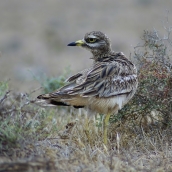This steppe bird measures from 38-45 cm in length, wingspan from 76-88 cm. The cryptic colouring provides excellent camouflage for its habitat: streaky-brown plumage, dark bands on the head, back and breast, in sharp contrast with white stripes on both wings, and a white line over each eye. The black-tipped bill is short, and the large eyes are yellow and perfectly adapted for night vision. Stone curlews have long legs and three toes. In Macaronesia, they only breed in the Canaries, where there are two subspecies: B. o. insularum, on Fuerteventura, Lobos, Lanzarote, La Graciosa and Alegranza, and B. o. distinctus, on Gran Canaria, Tenerife, La Gomera, La Palma and El Hierro. Vagrant birds flying from Africa or Europe have also been recorded in the Azores and Madeira, and several Canary Islands. Their typical habit encompasses low- to mid-altitude flatlands or gently sloping plains, particularly where shrub vegetation is scarce and there are large expanses of bare ground or low grasses. On La Palma and El Hierro, their range extends to the lower edges of pine forests and they may nest in forest glades. Their habitat also includes rocky, stony and sandy terrain, as well as malpaíses or badlands. Stone curlews are found at sea level up to 1,000 m, but in Tenerife they have been observed at higher altitudes. They feed on invertebrates (insects, snails and others), small reptiles, mice, frogs and the occasional small passerine, and hunt for food at compost heaps, rubbish dumps, golf courses, ponds and where livestock gather. The breeding season stretches from December to June and is determined by rainfall. On the eastern islands and islets, these birds are the first to nest. They lay two eggs in a tiny hollow in the ground, usually near a low bush, where the chicks can find shelter. This gregarious bird generally gathers in large flocks (around a hundred specimens), once the breeding season is over. This species is relatively abundant in Fuerteventura, Lanzarote and La Graciosa, less common and more localized in La Palma and La Gomera and very common in El Hierro and Gran Canaria. In Tenerife, however, its distribution area shrank considerably in the last century and the species has disappeared from the north flank. The subspecies B. distinctus is particularly threatened and much affected by the destruction or fragmentation of its habitat, human encroachment, poaching, roadkill, insecticides, predation by introduced animals and collision with electricity pylons. The latter has negatively impacted on populations in Fuerteventura and Lanzarote. Total numbers of B. o. distinctus have been estimated at fewer than 450 pairs and it has been classified as Vulnerable.













